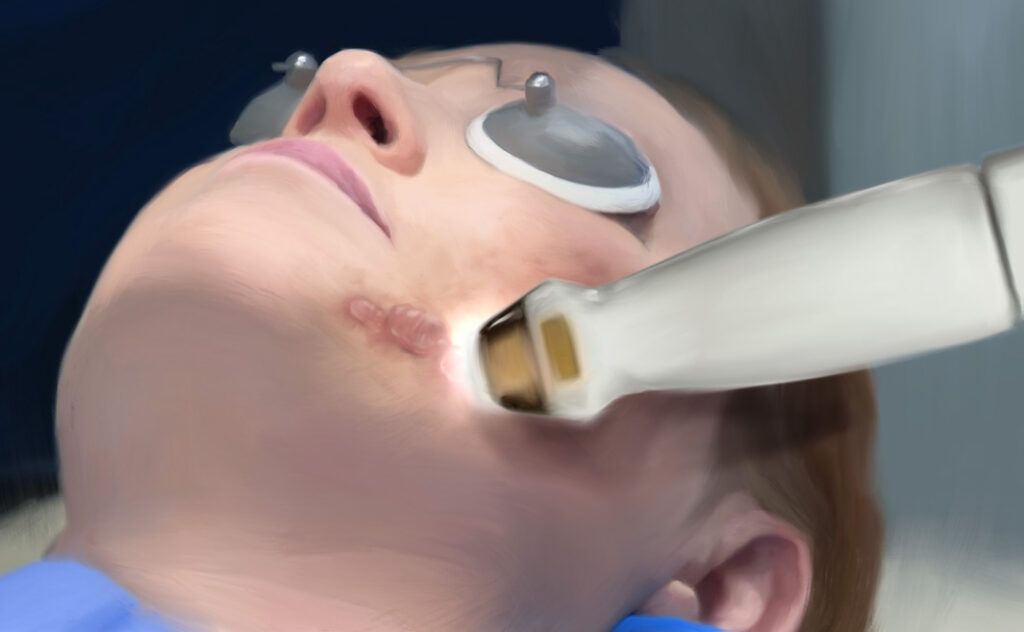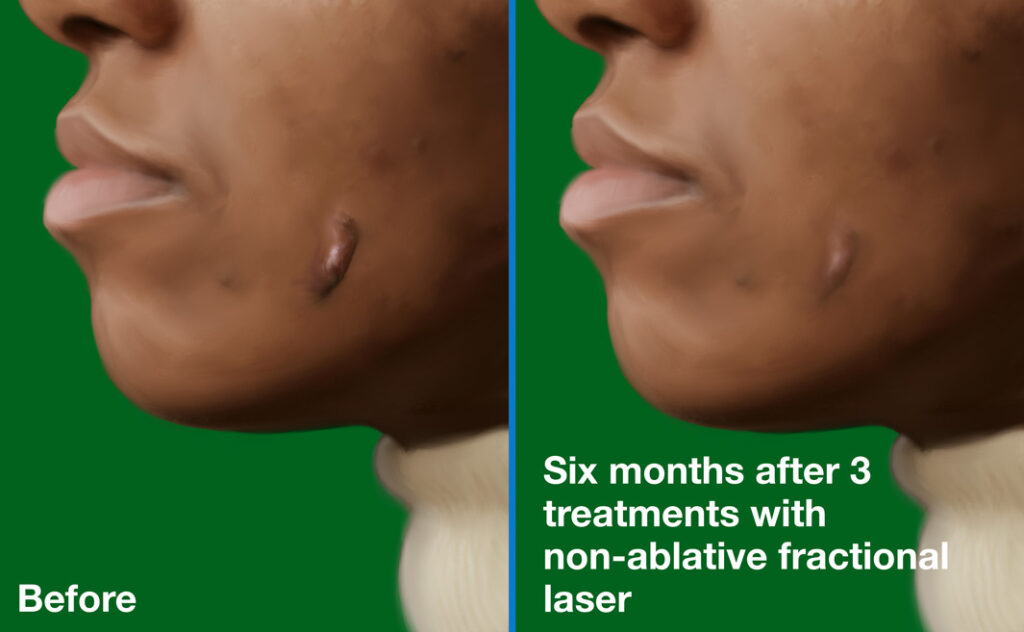Non-ablative (non-skin-removing) lasers work by shining an intense beam of light onto the skin, causing a controlled injury in the dermis (the deep layer of the skin) without ablating (removing) the epidermis (skin surface). Non-ablative laser treatment degrades excess collagen in the scar tissue and reduces the appearance of a raised scar.1
Because non-ablative lasers cause the skin to slowly reshape itself from the inside (from the dermis), the results they achieve are more gradual and moderate compared to ablative lasers, which ablate (remove) the epidermis, but they offer the advantages of a short recovery time and a relatively low risk of side effects.2
Non-ablative lasers can come in one of two forms:
- Fractional lasers, also known as fractionated lasers: These newer lasers deliver many small pinpoints of laser light in a grid-like pattern so that areas of skin in-between the pinpoints are left untouched. Because a smaller portion of the skin is damaged, healing time is shorter than with non-fractional lasers.
- Non-fractional lasers, also known as non-fractionated lasers: These older lasers treat the whole skin surface without leaving any gaps. Because an entire section of skin is damaged, healing time is longer than with fractional lasers.3
Non-ablative fractional lasers:
- How they work: Create a controlled injury in the dermis in a grid-like pattern
- # of treatments: 3-5 treatments at intervals of 1 to 2 months3
- Advantages: Low risk of side effects, relatively safe for darker-skinned people
- Disadvantages: Moderate results, requires multiple sessions
There are different subtypes of lasers, each named after the material used inside the laser device, and your doctor can discuss with you which is better for your particular raised scar(s). Lasers can be created using glass, crystals, or gasses, and the specific material determines the color of the laser light.1-8
The materials in lasers used for non-ablative fractional skin resurfacing include:
- Nd:YAG (neodymium:yttrium-aluminum-garnet) fractional laser
- Er:Glass (erbium glass) fractional laser2
Each laser subtype penetrates the skin to a different depth. In general, non-ablative fractional lasers penetrate deep into the dermis.
- Nd:YAG (neodymium:yttrium-aluminum-garnet) laser: Goes deep into the dermis and reaches the subcutaneous fat
- Er:Glass (erbium glass) fractional laser: Does not go as deep into the dermis as Nd:YAG (neodymium:yttrium-aluminum-garnet) lasers

As with all scar revision treatments, the non-ablative fractional laser is sometimes combined with other scar revision procedures to attain the desired results.
Non-ablative fractional laser treatment cannot be performed when there is an active skin infection or skin condition such as a bacterial infection, eczema, or psoriasis. Ensure your skin is clear before seeking laser resurfacing.4-8
Doctors do not recommend undergoing laser scar treatment for 6 months after taking oral isotretinoin (Accutane®), because during this time, the skin may respond unpredictably to laser treatment.4-8
Before agreeing to undergo laser resurfacing, discuss your treatment options, expected outcomes, and treatment prices with multiple doctors.
Procedure details:

Before booking your treatment, your doctor should first schedule a session to discuss the procedure, expected results, and possible complications with you and to answer your questions.
Laser resurfacing is usually performed in an outpatient setting.
During the treatment, the doctor will give you protective eyewear to prevent the laser from damaging your eyes.
In general, non-ablative fractional lasers do not cause major skin damage. How much skin damage any given laser produces can vary significantly depending on the type of laser and the laser machine settings. Your doctor will have to fine-tune the laser settings in order to get the best results while minimizing recovery time and side effects.
Once the settings are dialed in, your doctor may first apply a cooling gel to the skin to enhance the effectiveness of the laser and to protect the skin from burning. Alternately, many non-ablative fractional lasers now incorporate cooling mechanisms, built-in cooling devices, or external cooling systems to minimize discomfort and protect the surrounding tissues.9
Next, your doctor will go over your scar several times with the laser, which can produce mild pain.
Anesthesia:
Laser scar treatment can be uncomfortable and even painful. To numb your skin before the procedure, your doctor may:
- Apply a topical anesthetic to your skin 30 to 60 minutes before treatment
- Provide you with a topical anesthetic to apply to your skin before you arrive for your treatment7-9
Before-and-after:

Raised scar before and 6 months after 3 treatments with non-ablative fractional laser
References
- Heidari Beigvand H, Razzaghi M, Rostami-Nejad M, Rezaei-Tavirani M, Safari S, Rezaei-Tavirani M, Mansouri V, Heidari MH. Assessment of Laser Effects on Skin Rejuvenation. J Lasers Med Sci. 11(2), 212-9 (2020).
- Tretti Clementoni M, Azzopardi E. Minimally Invasive Technologies for Treatment of HTS and Keloids: Fractional Laser. 2020 Dec 8. In: Téot L, Mustoe TA, Middelkoop E, Gauglitz GG, editors. Textbook on Scar Management: State of the Art Management and Emerging Technologies [Internet]. Cham (CH): Springer. Chapter 33 (2020).
- Mattos, R., Jordão, J.M., Signor, K.C., de Souza, L.G. (2017). Non-ablative Fractional Lasers for Scars. In: Issa, M., Tamura, B. (eds) Lasers, Lights and Other Technologies. Clinical Approaches and Procedures in Cosmetic Dermatology. Springer, Cham.
- Cho S, Jung JY, Shin JU, Lee JH. Non-ablative 1550 nm erbium-glass and ablative 10,600 nm carbon dioxide fractional lasers for various types of scars in Asian people: evaluation of 100 patients. Photomed Laser Surg. 32(1), 42-6 (2014).
- Graber EM, Tanzi EL, Alster TS. Side effects and complications of fractional laser photothermolysis: experience with 961 treatments. Dermatol Surg. 34(3), 301-5 (2008).
- Tierney E, Mahmoud BH, Srivastava D, Ozog D, Kouba DJ. Treatment of surgical scars with nonablative fractional laser versus pulsed dye laser: a randomized controlled trial. Dermatol Surg. 35(8), 1172-80 (2009).
- Li K, Nicoli F, Cui C, Xi WJ, Al-Mousawi A, Zhang Z, Balzani A, Neill L, Sorge R, Tong Y, Zhang Y. Treatment of hypertrophic scars and keloids using an intralesional 1470 nm bare-fibre diode laser: a novel efficient minimally-invasive technique. Sci Rep. 10(1), 21694 (2020).
- Jang JU, Kim SY, Yoon ES, Kim WK, Park SH, Lee BI, Kim DW. Comparison of the Effectiveness of Ablative and Non-Ablative Fractional Laser Treatments for Early Stage Thyroidectomy Scars. Arch Plast Surg. 43(6), 575-81 (2016).
- Goldberg DJ, Rogachefsky AS, Silapunt S. Non-ablative laser treatment of facial rhytides: a comparison of 1450-nm diode laser treatment with dynamic cooling as opposed to treatment with dynamic cooling alone. Lasers Surg Med. 30(2), 79-81 (2002).
 Acne.org Products
Acne.org Products